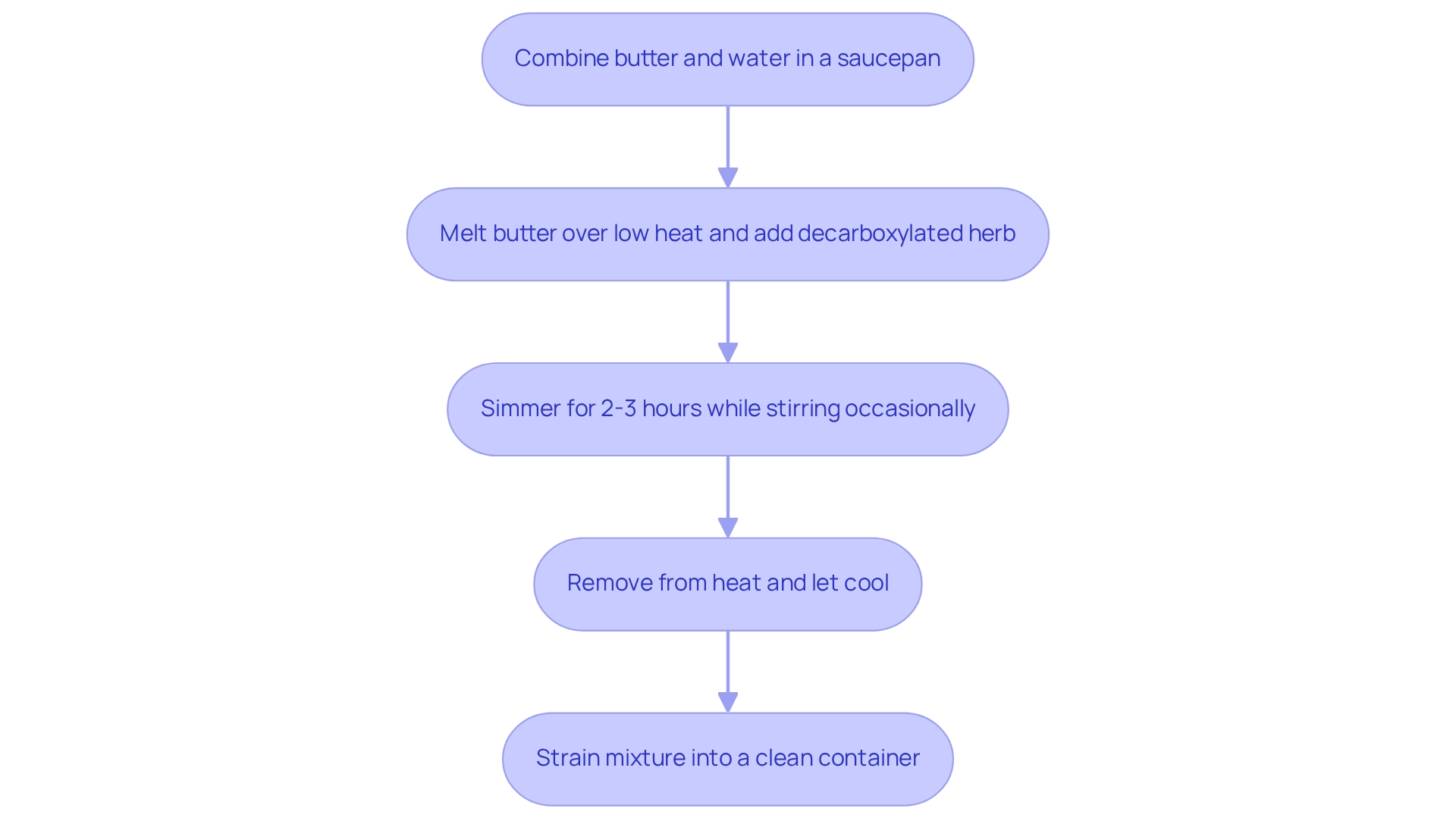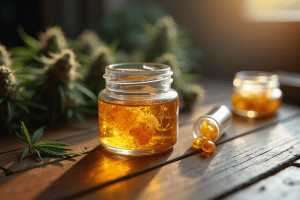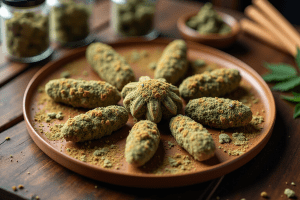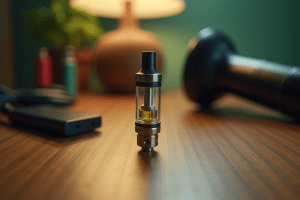Overview
This article offers a caring, step-by-step guide on how to make weed butter. It highlights the importance of:
- Decarboxylation
- Ingredient preparation
- Infusion techniques
- Dosage calculation for safe consumption
Have you ever wondered how to activate THC for potency? By detailing each phase, from this essential activation to ensuring accurate dosage, we aim to equip you with the knowledge you need to create effective and enjoyable cannabis-infused butter. Together, let’s explore this rewarding process and make informed choices for your journey.
Introduction
In the world of cannabis culinary arts, we embark on a journey from plant to plate that beautifully blends art and science. Have you ever wondered how to unlock the full potential of cannabis for cooking? Particularly in the creation of cannabutter, a meticulous approach to decarboxylation and infusion is essential. By understanding the precise steps to activate THC and appreciating the importance of quality ingredients, we can elevate our culinary creations together while ensuring safe and enjoyable consumption.
This guide delves into the essential techniques and best practices for crafting potent cannabutter. It empowers you to explore the flavorful possibilities that cannabis-infused cooking has to offer. Let’s take this journey together, discovering how to enhance our cooking with compassion and care.
Decarb Cannabis: Activate THC for Maximum Potency
To effectively decarb your cannabis and activate its THC for maximum potency, let’s follow these nurturing steps together:
- Preheat your oven to 150°C (approximately 302°F). This temperature is optimal for achieving a 70% yield of Δ-THC from THCA, ensuring you get the most out of your herb.
- Break up the marijuana buds into smaller pieces. Remember, it’s best not to grind them too finely; larger pieces allow for better heat distribution.
- Spread the herb evenly on a baking sheet lined with parchment paper. This will prevent sticking and ensure even heating, making the process smoother.
- Bake for 30-40 minutes, stirring every 10 minutes to promote uniform decarboxylation. You’ll know it’s done when the plant turns a light brown hue and emits a pleasant scent.
- Allow the decarbed plant material to cool before you start learning how to make weed butter by incorporating it into your cannabutter recipe.
This method not only enhances the potency of your edibles but also aligns with scientific principles that emphasize the importance of precise temperature control during the decarboxylation process. As MDBuds notes, “I compiled all the research I did based on lab tests at clubs and from home growers that have test kits,” highlighting the value of research in achieving consistent results. Understanding cannabinoid conversion rates during storage underscores the significance of proper decarboxylation, ensuring that your infused recipes deliver the desired effects. By adopting a systematic approach, as emphasized in recent case studies, you can ensure consistent outcomes and a more enjoyable experience with the plant. Together, let’s explore this rewarding journey of enhancing your cannabis experience.
Gather Ingredients and Tools: Essentials for Cannabutter
To successfully learn how to make weed butter, it’s essential to gather the right ingredients and tools. This thoughtful preparation not only sets the stage for a delightful cooking experience but also nurtures your creativity in the kitchen. Here’s what you’ll need:
Ingredients:
- 1 cup (2 sticks) of unsalted butter
- 1 cup of water (to help regulate temperature)
- 1 cup of decarboxylated herb (approximately 7-10 grams, depending on your desired strength)
Tools:
- A saucepan or double boiler
- A stirring spoon
- A fine mesh strainer or cheesecloth
- A baking sheet
- Parchment paper
- An oven
- A storage container for the finished infused butter
Having these items ready will streamline your cooking process and ensure a successful infusion. As Bill Hicks famously noted, ‘It grows naturally upon our planet,’ reminding us of the cultural significance of this plant in our lives. Have you ever considered how using high-quality ingredients can elevate your culinary creations? Culinary experts emphasize that understanding how to make weed butter with quality ingredients is crucial for achieving the best flavor and potency. Christine Burns Rudalevige, former Editor-in-Chief of edible MAINE, highlights that the right ingredients can truly enhance your cooking experience.
Additionally, the average quantity of marijuana used in homemade recipes typically ranges from 7 to 10 grams. This balanced infusion caters to various preferences, allowing you to personalize your approach. This preparation not only enriches your cooking journey but also aligns with the growing trend of how to make weed butter, which emphasizes creativity and personalization in the kitchen. Sharing recipes and experiences within the herb community can further enhance this journey, reflecting Leafy Mate’s mission to build a community of informed consumers. Together, let’s explore the wonderful possibilities that come with understanding how to make weed butter!
Infuse the Fat: Step-by-Step Cannabutter Preparation
To understand how to make weed butter effectively, let’s follow these thoughtful steps together:
- Start by combining butter and water in a saucepan as part of the process on how to make weed butter. Gently heat the mixture over low heat until the butter is fully melted.
- Once the butter has melted, add your decarboxylated herb to the saucepan as part of the process on how to make weed butter. Stir the mixture thoroughly to ensure the herb is evenly distributed throughout the melted butter. To learn how to make weed butter, it’s important to maintain a low heat, ideally between 160°F and 200°F, allowing the mixture to simmer for 2-3 hours. Stir occasionally to prevent any burning.
- After simmering, remove the saucepan from heat and let it cool slightly.
- Using a fine mesh strainer or cheesecloth, strain the mixture into a clean container, discarding the plant material. Your cannabutter is now ready for use! This method not only highlights how to make weed butter through careful temperature regulation but also reflects current trends in infusion techniques, ensuring a high-quality product. As the marijuana market evolves, new products and methods are emerging, such as alcohol-free beer brewed from hemp. It’s essential to stay informed about the best practices for home infusion.
With a growing consumer trust in online marijuana information—reported at 70% overall and 90% among recent users—it’s crucial to rely on transparent and educational resources when experimenting with cooking using this substance. Remember, as Chef Wan beautifully states, ‘I believe that food can unite people from all walks of life and cultures.’ This sentiment underscores the importance of intentionality in cooking, as highlighted by Esther Choi’s approach to considering the purpose behind each ingredient. Together, let’s explore the wonderful world of cooking with cannabis, making informed choices that enhance our culinary experiences.
Calculate Dosage: Ensure Safe Consumption of Cannabutter
To accurately calculate the dosage of your cannabutter, let’s follow these steps together:
- Determine the THC content of your marijuana strain. For example, if your strain has 20% THC, that means there are 200 mg of THC per gram.
- Calculate total THC: If you used 7 grams of the plant, the total THC would be 1400 mg (7 grams x 200 mg).
- Divide for servings: If you made 1 cup of infused butter (approximately 16 tablespoons), divide the total THC by the number of servings. For instance, 1400 mg THC ÷ 16 tablespoons = 87.5 mg THC per tablespoon.
- Start small: Begin with a small amount (1/4 to 1/2 tablespoon) to assess your tolerance. Remember, the effects of edibles can take longer to manifest compared to smoking or vaping. Adjust your dosage for future use based on your experience.
Understanding how to make weed butter is essential for knowing its strength. The industry often discusses potency in milligrams, which can be confusing. Health experts emphasize that knowing how to make weed butter responsibly is key to enjoying the benefits safely. Many users share personal experiences highlighting the variability in effects based on individual tolerance, underscoring the importance of cautious experimentation. A case study titled “Personal Experiences with Edibles” reinforces that users should learn their own limits, as effects can vary significantly.
Additionally, it’s crucial to be aware of the long-term consequences of marijuana use, which may take decades to fully understand, much like tobacco. As you navigate your cannabis journey, remember that understanding legalization and policy reform can empower you as a consumer, ensuring informed and safe consumption. Together, we can foster a community that prioritizes safety and understanding.
Conclusion
Mastering the art of creating cannabutter is a beautiful blend of science and culinary technique, one that invites us to explore and connect with our passions. By starting with the crucial step of decarboxylation, we activate THC and enhance potency, ensuring that our final product delivers the desired effects. When we follow precise temperature controls during this process, we not only maximize yield but also maintain the integrity of the cannabinoids, laying a strong foundation for successful infusion.
Gathering quality ingredients and the right tools is equally important in this journey. The choice of butter, water, and decarboxylated cannabis can significantly influence the flavor and potency of our cannabutter. By utilizing high-quality components, we transform the cooking experience into a creative endeavor that nourishes us and connects us with the cultural significance of cannabis in our lives.
The infusion process itself requires our attention to detail, emphasizing low heat and careful stirring to achieve a well-blended product. Moreover, calculating the dosage accurately ensures safe consumption, allowing us to enjoy the experience without the risk of overindulgence. Understanding our individual tolerance and starting with smaller amounts is essential for responsible use, as the effects of edibles can vary widely.
In conclusion, embracing the journey of cannabis-infused cooking fosters a deeper appreciation for both the culinary arts and the potential benefits of cannabis. By following these guidelines, we can create delicious, potent cannabutter that enhances our cooking while celebrating the communal spirit of sharing recipes and experiences. As the cannabis culinary scene continues to evolve, let us stay informed and intentional in the kitchen, leading us to fulfilling and safe culinary adventures together.
Frequently Asked Questions
What is the purpose of decarboxylating cannabis?
The purpose of decarboxylating cannabis is to activate its THC, enhancing the potency of the herb for use in edibles.
What temperature should I preheat my oven to for decarboxylation?
You should preheat your oven to 150°C (approximately 302°F) for optimal results.
How should I prepare the marijuana buds before baking?
Break up the marijuana buds into smaller pieces, but avoid grinding them too finely, as larger pieces allow for better heat distribution.
How do I arrange the cannabis on the baking sheet?
Spread the herb evenly on a baking sheet lined with parchment paper to prevent sticking and ensure even heating.
How long should I bake the cannabis, and how often should I stir it?
Bake the cannabis for 30-40 minutes, stirring every 10 minutes to promote uniform decarboxylation.
How can I tell when the decarboxylation process is complete?
The process is complete when the plant turns a light brown hue and emits a pleasant scent.
What should I do after the cannabis has been decarbed?
Allow the decarbed plant material to cool before incorporating it into your cannabutter recipe.
Why is precise temperature control important during decarboxylation?
Precise temperature control is important because it ensures a higher yield of Δ-THC from THCA, maximizing the potency of your edibles.
Get Your Medical Card
Connect with a licensed physician online in minutes













